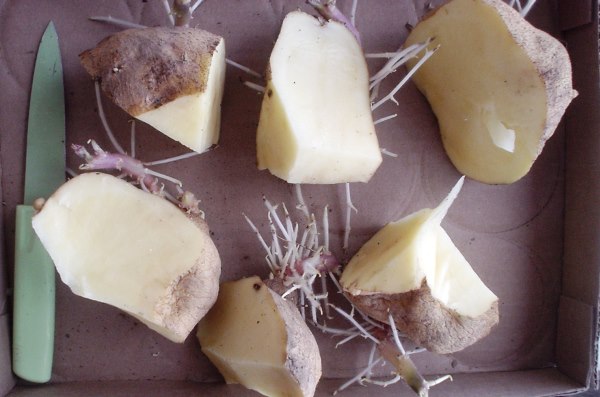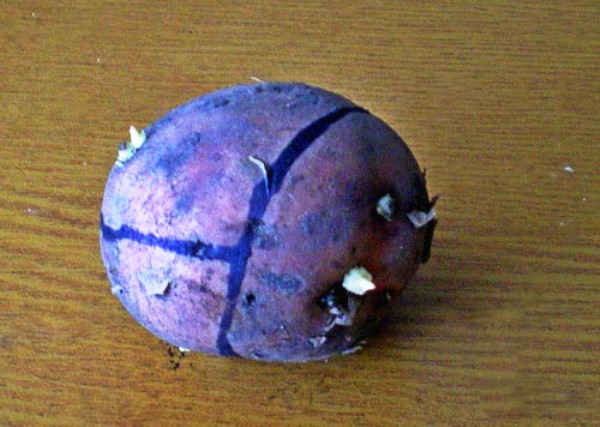Technology and advantages of planting potatoes with eyes
Potatoes in our country are rightfully considered the second bread. Each summer resident devotes most of the garden for planting crops. The subsequent harvest directly depends on the potato variety. Therefore, it becomes difficult to acquire a sufficient amount of planting material. There is a method that allows you to significantly reduce the consumption of seeds - planting potatoes with eyes. Using this method, you will need 2-3 times less planting material, and with proper soil preparation and seedling care, a rich harvest will be provided. Among the main advantages of the method, a decrease in the incidence of potatoes is noted, since only part of the tuber is used. You will not need to lug several bags of planting material into the garden. It will be possible to effectively change varieties in the future.
Content
Preparation of planting material
First of all, it is necessary to carry out the correct preparation of seed material. Not all tuber eyes are suitable for planting. Before preparation, it is necessary to discard sick, frozen potatoes. Usually tubers are selected in the size of 50-70 g, since the eyes from small potatoes are not so productive.
It is important to create optimal microclimatic conditions in the place where the seed is stored. Do not pour them into the basement immediately after cutting. This can lead to rotting of the tubers. If you store the seeds in a dry room, they will simply dry out. It is best to keep the sliced potatoes at room temperature. The layer should be only one, maximum two rows. When stored in the basement, you can pour the parts in a layer of 5-7 cm for a period of 8-10 days. During this time, the sections should be tested, that is, they should be coarse.
From time to time, it is necessary to revise the planting material and select rotten parts. It is also worth throwing away suspicious specimens. If the indoor air is very dry, you can sometimes spray the tubers to prevent them from wilting.
To increase yields and accelerate the emergence of seedlings, experienced gardeners advise vernalization of potatoes. For this purpose, parts of the tubers that should go for planting are laid out in diffused light at a temperature of 15-20 degrees (room temperature). This will allow the eyes to germinate faster. The sprouts obtained in this way are called light sprouts. They should be short, coarse, green in color, with leaf buds. Sometimes roots even appear. Carrying out such manipulations with seed will reduce the period between planting and emergence by almost half.
For 35-40 days before planting, the planting material must be removed from the storage location and warmed up. The optimum heating temperature is 18-2o degrees. In such conditions, the potatoes must stay for at least 4 days. When the first eyes appear, the seeds must be laid out in boxes in 2-3 layers and exposed to light at a temperature of 8 degrees.
Usually for this, the boxes are taken out into the street. The temperature can be adjusted with plastic wrap. Under these conditions, the tubers continue to germinate. The sprouts grow 2-3 cm in 28-35 days and acquire a greenish-purple color. A day or two before planting, the potatoes should be divided into parts. The number of parts is equal to the number of eyes.
Questions often arise about how to properly divide a seed tuber, at the top of which several eyes have formed. In this case, the top is divided vertically into 2-3 slices. At the same time, it is advised not to plant such slices nearby.
Landing technique
Seed potatoes are planted in insulated ridges. It is best to land in a sunlit location protected from the winds. When planting under a shovel, first mark the field at a distance of 50-60 cm. The furrow should be made about 6 cm deep. The bottom of the grooves should be well loosened. Planting is carried out every 10-15 cm in a row. Thus, the roots grow in different directions, they have enough room, and therefore there is no competition and optimal nutrition is provided. The pieces are laid out with a cut down, and sprouts up, slightly pressing into the soil. Small slices should be placed more often, and large ones less often. Next, the seeds are sprinkled with earth, which forms a roller 8-10 cm high and with a base width of 35 cm. Usually, after 2.5-3 weeks, potato shoots will appear, then you need to make the roller higher - up to 25-27 cm, with a width of 65-70 cm.
Some gardeners use a planting scheme of 15 by 30 cm.In this case, hilling is not provided, therefore, parts of the seed tubers are planted at a depth of more than 12 cm to prevent their greening. In this case, the potatoes need to be mulched when the temperature rises to 20 degrees Celsius.
Growing tips
When you saw that the weeds began to grow en masse, you need to fight them. Harrowing is carried out to clear the field and simultaneously loosen the land. This method is optimal for a planting depth of 7-10 cm. If you have carried out a shallower planting, you should use manual weeding tools so as not to damage the plants. This treatment must be carried out 2-3 times.
Also, one of the methods of care is watering the plants. Usually, 2 waterings are carried out: pre-sowing and at the beginning of flowering. If the year is dry, then you can re-irrigate with massive flowering of potatoes.
It is advised to sow legumes next to potatoes: peas, beans, beans. Provide such a neighborhood with nitrogen, the plants will shade the soil, and also scare off pests. If you leave wide aisles (up to 90 cm), then it is recommended to plant so-called compactors on them: cabbage, beets, onions, radishes and flowers: cosmea, calendula, yarrow, etc.
To increase the yield, it is recommended to feed the plants. If necessary, mineral fertilizers are applied, although organic fertilizers are usually recommended in the form of bird droppings. But remember that you should not overuse feeding either. It is necessary to take into account the quality of the soil, the amount of fertilizer applied before planting.
Also, the main problem when growing potatoes is pests: the Colorado potato beetle and wireworm. There are many chemicals that are used for pre-sowing treatment of seeds from parasites, or the treatment can be carried out during the growing season when the larvae appear. There are many different folk ways to fight. To destroy the Colorado potato beetle, plantings are sprinkled with onion husks or ash, calendula is sown over the entire area. Mustard is sown from the wireworm as a green manure crop.
Growing potatoes with eyes has a large number of advantages, among which they note: saving seed, reducing the incidence of the plant, reducing competition between the stems and sufficient nutrition. Thus, using this planting method, you will get an excellent harvest and save money on the purchase of seed.
Video "Planting potatoes with eyes (shares)"
The video shows how to properly plant potatoes with eyes, gives advice on planting and caring for the plant.






